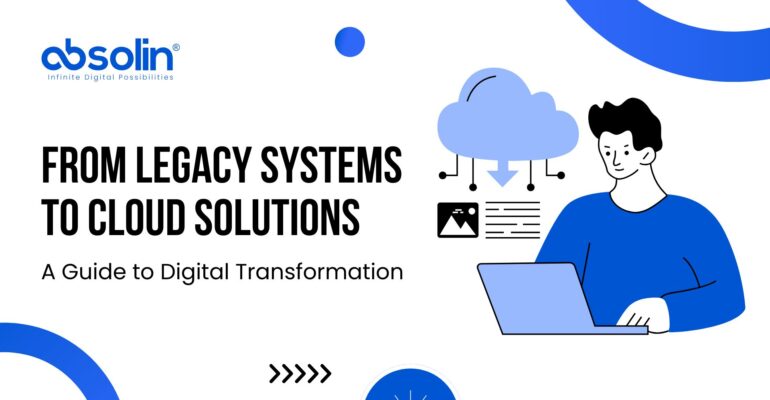From Legacy Systems to Cloud Solutions: A Guide to Digital Transformation

From Legacy Systems to Cloud Solutions: A Guide to Digital Transformation
When Yesterday’s Systems Hold Back Tomorrow’s Growth
Every business has that one system, the one everyone depends on but no one dares to touch. It’s been around for years, patched together by generations of IT teams, running mission-critical processes that somehow still work. It’s dependable. It’s familiar. But it’s also limiting.
That’s the irony of legacy systems: they were once built for efficiency, but over time, they’ve become the very barrier to it. Outdated infrastructure, slow updates, security vulnerabilities, and lack of integration with modern tools quietly eat away at productivity and innovation.
And that’s where cloud-driven digital transformation changes the game. Moving from legacy systems to the cloud isn’t just a technology upgrade, it’s a strategic reinvention. It’s about building a business that’s faster, smarter, and future-ready.
This is your roadmap for making that shift — safely, effectively, and sustainably.
1. Why Legacy Systems Are Holding Businesses Back
Legacy systems aren’t inherently bad; they’ve simply outlived the environment they were built for.
Common challenges include:
- Limited scalability: Expanding capacity often means costly infrastructure upgrades.
- Integration headaches: Legacy software doesn’t play well with modern APIs or cloud platforms.
- High maintenance costs: Constant patching and manual updates drain IT budgets.
- Security risks: Older systems lack modern encryption and threat-detection capabilities.
- Data silos: Disconnected systems lead to inconsistent insights and slower decisions.
In short: legacy systems keep the lights on, but they don’t help the business shine brighter.
2. Why the Cloud Is the Natural Successor
The cloud represents not just where your data lives, but how your business operates. It’s about agility, accessibility, and innovation.
Here’s what cloud solutions bring to the table:
- Scalability on demand: Instantly scale resources up or down based on usage.
- Cost efficiency: Pay only for what you use, reducing capital expenditure.
- Global accessibility: Enable remote teams and global collaboration.
- Enhanced security: Benefit from enterprise-grade encryption, redundancy, and compliance.
- Continuous innovation: Get automatic updates, new features, and better performance without downtime.
With cloud adoption, your business gains more than infrastructure, it gains freedom to grow.
3. The Digital Transformation Roadmap
Moving from legacy systems to cloud solutions isn’t just a lift-and-shift exercise. It’s a strategic journey that requires planning, alignment, and precision.
Step 1: Evaluate Your Current Systems
Identify which legacy systems are mission-critical, which can be modernized, and which should be replaced entirely.
Step 2: Define Business Objectives
Is your goal to improve performance? Cut costs? Enable better analytics? Your transformation should align with measurable outcomes.
Step 3: Choose the Right Cloud Model
- Public Cloud: Scalable and cost-effective for most businesses.
- Private Cloud: Enhanced control for data-sensitive industries.
- Hybrid Cloud: The best of both worlds for gradual transition and flexibility.
Step 4: Plan Your Migration Strategy
- Rehost: Move applications as they are (“lift and shift”).
- Refactor: Modify parts for better cloud performance.
- Rebuild: Redesign from scratch using cloud-native architectures.
Step 5: Ensure Security and Compliance
Build robust identity management, data encryption, and monitoring into your cloud infrastructure.
Step 6: Upskill Your Team
Technology is only as powerful as the people using it. Train employees to embrace new systems confidently.
Step 7: Monitor, Optimize, and Evolve
Digital transformation doesn’t end at migration. Continuously analyze performance, costs, and usage to maximize ROI.
4. Real-World Impact: Cloud Transformation in Action
- Finance: Automated reporting, real-time analytics, and compliance-ready systems.
- Manufacturing: IoT-enabled operations and predictive maintenance.
- Retail: Personalized customer experiences powered by real-time data.
- Healthcare: Secure patient management systems accessible from anywhere.
- Logistics: End-to-end visibility across global supply chains.
Across industries, businesses are proving that the move to the cloud unlocks growth, innovation, and resilience.
5. Challenges Along the Way (and How to Overcome Them)
| Challenge | Impact | Solution |
| Data migration complexity | Data loss or downtime | Use phased migration and backups |
| Cultural resistance | Employee pushback | Conduct training and change management |
| Security concerns | Compliance risks | Implement IAM, encryption, and auditing |
| Integration issues | Process gaps | Use middleware and APIs |
| Cost management | Budget overruns | Leverage usage monitoring and automation tools |
With the right strategy and the right partner, these hurdles become stepping stones.
Conclusion: Transform, Don’t Just Transition
Digital transformation isn’t about abandoning the past, it’s about upgrading it for the future. The cloud doesn’t erase what your legacy systems built; it amplifies it, enabling faster innovation, smarter collaboration, and data-driven agility.
Think of it this way: your legacy system is like an old engine, powerful in its time but limited by today’s terrain. The cloud is your upgrade — lighter, faster, smarter, and built to navigate the digital highways ahead.
The question isn’t whether your business can afford to move to the cloud, it’s whether you can afford not to. The longer you wait, the further ahead your competitors get.
Where Absolin Can Help
At Absolin, we help businesses evolve from legacy dependence to digital dominance. Our cloud transformation experts specialize in:
- Assessing legacy systems to identify modernization priorities.
- Designing custom cloud migration strategies (public, private, or hybrid).
- Developing cloud-native applications tailored to your workflows.
- Ensuring compliance, data security, and minimal downtime.
- Integrating ERP, CRM, and IoT systems for seamless digital ecosystems.
With Absolin, digital transformation isn’t a disruption, it’s an evolution. We help you reimagine your business for agility, scalability, and growth in the cloud era.


